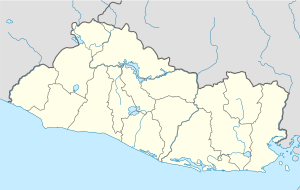Juayúa
| Juayúa | ||
|---|---|---|
|
Coordinates: 13 ° 51 ′ N , 89 ° 45 ′ W Juayúa on the map of El Salvador
|
||
| Basic data | ||
| Country | El Salvador | |
| Department | Sonata | |
| Residents | 24,465 (2007) | |
| Detailed data | ||
| surface | 103.06 | |
| height | 440 m | |
| Time zone | UTC −6 | |
| City Presidency | Rafael Orlando Contreras Gámez ( ARENA ), 2009–2012 | |
Juayúa is a municipality in El Salvador in the Sonsonate department . It is located in the far north of the department on the border with Ahuachapán .
Surname
The name Xuayúa ( x pronounced like "sch") comes from the Nawat (Pipil) and is derived from the plant name xuayu or xuayut , a red or purple-colored flowering orchid species .
history
The area of Xuayúa was probably settled by the Nahua ethnic group Pipil before 900 . Around 1200 it came under the rule of Cuzcatlan .
In 1528 all of Cuzcatlan was conquered by the Spaniards under Pedro de Alvarado .
Around 1838 or 1839, during the reign of Jefe Supremo Timoteo Menéndez , the large landowning families Larín, Mata and Salaverría began to grow coffee .
According to a communal information sheet of December 3, 1859, Juayúa had 1849 inhabitants, all of whom lived from agriculture. Coffee, wheat , aniseed , flax and mustard were grown in Juayúa . Of the 399 houses, only two were roofed with tiles, the rest with thatch. The population spoke Nawat (Pipil) .
By two government decrees by President Rafael Zaldívar in 1881 and 1882, the property rights of the indigenous communities in El Salvador were revoked and the jointly managed ejidos were dissolved. As a result, the large landowners in Juayúa expanded their coffee plantations at the expense of the indigenous people.
On May 1, 1906, Juayúa received city rights. On September 6, 1915, it was destroyed by an earthquake that had its epicenter in Mount Cuyotepe (“Coyote Mountain”).
In January 1932, Juayúa was a stronghold of the peasant movement and the first city to be captured by insurgent peasants on January 23rd. Under the leadership of Francisco Sánchez , a member of the PCS , farmers occupied the town hall (alcaldía) . The large landowner Emilio Radaelli, his wife and the commander of the city, Coronel Mateo Vaquero, died in the fighting. Sánchez had all alcohol poured out to prevent his followers from getting drunk. He also had the land titles handed over to him by the Grundamt in order to prepare a land distribution among the farmers who supported him. The women had to wear red dresses, the color of the revolutionary Sánchez's party.
Juayúa was stormed by the army after just three days . Francisco Sánchez was seized, taken through the surrounding villages and then shot together with comrades. After the suppression of the uprising, the Matanza , a massacre that killed around 30,000 people in all of El Salvador in early 1932, over a quarter of the total population in Juayúa.
The nawat (pipil) , which until then had been the language of the rural population of Sonsonates, was banned. Those who spoke Nawat or wore traditional clothing were at risk of death because people were killed because of these distinguishing features. The Nawat language was no longer spoken in public and died out in Juayúa.
Born in Juayúa
- Eusebio Rodolfo Cordón Cea (1899–1966), 1962 President of El Salvador
- Francisco Sánchez († 1932), Salvadoran peasant leader and revolutionary
Individual evidence
- ↑ Resultados Alcaldes Electos en El Salvador para 2009-2012 ( Memento of the original from December 28, 2010 in the Internet Archive ) Info: The archive link was inserted automatically and has not yet been checked. Please check the original and archive link according to the instructions and then remove this notice.
- ^ Dermot Keogh (1982): El Salvador 1932. Peasant Revolt and Massacre.
- ↑ Miguel Mármol: Francisco Sánchez (Héroe de 1932)
- ^ Paul D. Almeida: Organizational expansion, liberalization reversals and radicalized collective action. In: Harland Prechel (ed.): Politics and globalization 15, 2007, pp 57-97.
- ↑ Hugh Byrne: El Salvador's Civil War: A Study of Revolution. Boulder, Colorado, Lynne Rienner Publishers, 1996
